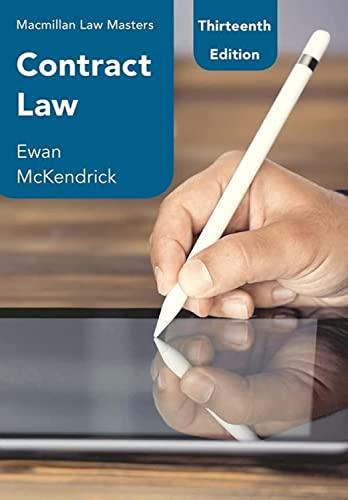Question
why is the case significant? what is the case really about? what types information am i being given to analyze? What other marketing lessons do
why is the case significant?
what is the case really about?
what types information am i being given to analyze?
What other marketing lessons do you think the INO example suggests? Offer additional strategic recommendations that might be helpful. What types of changes could occur in the marketplace that would affect INO's success? How could they prepare for these changes?
Case: In-N-Out BurgerKeeping It Simple
In 1948, Harry and Esther Snyder decided to open a drive-thru hamburger stand in California called the In-N-Out (INO) Burger. In the 1940s, fast-food restaurants didn't exist, and the two-way communication order box (or speaker) we are familiar with today was an innovation developed by Harry and an electronic expert at that time. While he didn't have it patented, it eventually became a common feature for fast-food restaurants today. INO was built based upon a simple philosophy that has steered the company for more than 60 years.
Give customers the freshest, highest quality foods you can buy and provide them with friendly service in a sparkling clean environment.26
The simplicity of the philosophy affects all aspects of the operations and marketing of the business. INO started out as a family business with Harry and his wife, and eventually their two sons got involved. The current CEO is his granddaughter, Lynsi Martinez, who took control of the business after several family members died in a plane crash.
Starting with one store in 1948, the business has grown to 420 INO locations with estimated annual profits of $420 million. In comparison, McDonald's has 31,000 locations worldwide and annual profits around $21 billion. Yet INO is estimated to be a close second with Burger King.27
Stacy Perman, author of the bookIn-N-Out Burger: A Behind-the-Counter Look at the Fast-Food Chain That Breaks All of the Rules,attributes INO's success to a kind of reversal, counterintuitive approach to doing business that prioritizes quality, customers, and employees over the riches that can come from rapid expansion, both geographically and through franchising.The thinking of not expanding rapidly and franchising was based on being able to control the quality of the food.While the philosophy may seem counterintuitive today, back in the 1940s, it wasn't. Being a product of the Depression era, these values would have been common with the times. Give people a good, healthy meal at a fair price and treat them with respect. Also, Harry never opened up a location unless he had the money and the staff fully trained. As part of this way of thinking, he paid his employees well, above the federal and state minimumwage requirements. Today, employees earn more than $10 an hour. To be consistent with his philosophy of giving customers friendly service, he knew his staff would need to feel good about themselves, and if they felt good about themselves by being paid well and working for a caring company, that they would naturally project positive, caring feelings with the customers. It was a win-win-win strategy for all parties.
What is also fundamental to the INO strategy was not to use the typical marketing hype done through traditional promotional strategies but to rely on the basics: quality, customers, and employees. "Instead of pouring hundreds of millions of dollars into ad campaigns like rivals Burger King (BKC) and McDonald's (MCD), In-N-Out relies mainly on its carefully located stores, billboards, bumper stickers, T-shirts, and its own rabid fans to broadcast its message."28The strategy is about word of mouth (WOM), and ultimately it resulted in an INO brand community with an ever-growing group of INO diehards.29Community members have even created their own "secret menu" that has gone viral on the Internet. While the INO menu is simple, only offering hamburgers, fries, and shakes, they allow customers to customize their orders to add or delete items. The "secret menu" has favorite customized options created by customers. Examples include Animal Style cheeseburger; vegetarians can order a Grilled Cheese, Double Meat (or 3 X 3 or 4 X 4), or a Protein Style burger.30Yet the main menu in the stores still only has hamburgers, fries, and shakes listed. Members have also taken on the responsibility of bringing in new devotees, referred to as "the conversion."31
The stores are simple in layout and clean. Every INO location is consistent in its dcor and cleanliness. They have no freezers, heating lamps, or microwave ovens. Everything is made fresh. The fries are made with real potatoes, and customers can watch them being peeled. Fresh tomatoes come in every other day and are hand washed. The buns are made fresh on site. They have even established their own commissary to have control over the quality of the ingredients. They also created an INO "University" where new managers are trained and taught the company philosophy. The packaging (e.g., cups) has references to biblical verses (e.g., John 3:16), which stems from the family's Christian background. To give back to the community, they started a foundation in 1995 to help abused and neglected children.32(They had actually been helping children since the early 1980s but set up the nonprofit organization to address the issue on a larger scale.)
According to blogger Andy Beaupre, the lessons to be learned from the INO brand include being focused, differentiating, happy employees, doing good, a clear mission, staying independent, a subtle versus an overt approach, consumer loyalty, cult-like popularity, and creating an emotional connection. Accordingly, "All this adds up to a personal brand experience built on adjectives (cool, great, caring) not nouns (burgers, restaurants, revenues). It's emotional branding at its best.
Step by Step Solution
There are 3 Steps involved in it
Step: 1

Get Instant Access to Expert-Tailored Solutions
See step-by-step solutions with expert insights and AI powered tools for academic success
Step: 2

Step: 3

Ace Your Homework with AI
Get the answers you need in no time with our AI-driven, step-by-step assistance
Get Started


